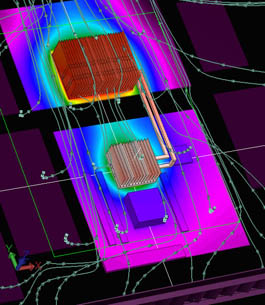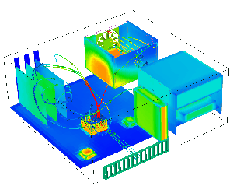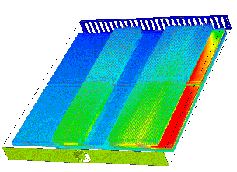Latest News
August 26, 2009
By DE Editors
 A heat pipe solution for LCD and Plasma TVs. Coolit image courtesy of CET Ltd. |
Daat Research Corp. (Hanover, NH) has released version 9 of Coolit, its CFD (computational fluid dynamics) software for analyzing and managing thermal and flow problems in complex electronic equipment. Coolit provides fully coupled and non-linear modeling of convection, conduction, and radiation in electronic systems. Additionally, it can handle mixed flows where regions of laminar, turbulent, and transitional flow co-exist. Major enhancements in Coolit v.9 include the ability to build complex IC chip models using one of three methods and two new compact resistor model options, according to the company.
With Coolit v.9, you can now build complex IC chip models with your choice of three methods. You can use what the company calls “model constructors” that guide you from start to finish. You can also build an IC model from scratch using basic Coolit building blocks, or you can select a model from the expanded Coolit IC Package library. The company says that a simple mouse click will convert your detailed IC package models into compact resistor models, if desired. The advantage of compact resistor models, according to Data Research, is that they dramatically reduce the computational resources necessary to compute complex models with large numbers of IC packages with little impact on accuracy. Coolit is said to provide instant conversion from constructor, library models, and user-built models.
Coolit v.9 incorporates two new compact resistor model options: a DELPHI option and a new 14-resistor model option. The DELPHI option lets you specify a resistor network using DELPHI methodology for generating environment-independent compact resistor models of IC packages. The 14-resistor compact model can be used for converting detailed models built in Coolit.
The Coolit solver leverages the finite volume discretization method. Solver features include steady state or transient modeling, four turbulence models optimized for convective heat transfer analyses, continuously updated displays of convergence history, and fan, porous media, cold plate (two fluid), and surface roughness models. Post-processing features include 2D and 3D display windows, on-line flow animation and visualization, the ability to color code components, interactive mouse-controlled graphics, and overlaid plots.
 Coolit from Daat Research Corp. |  This complex 3D case, modeled with Coolit, contains more than 60 different components and assemblies and uses 581,856 grid cells. |
Coolit v.9, which runs on Windows-based systems, now also provides 64-bit operating system support for CoolPlot, Coolit’s graphics post-processor. Miscellaneous features of Coolit include the ability to create libraries of reusable objects, CAD interfaces that support import from popular CAD applications, and a material properties database.
For more information, Daat Research Corp. on the web.
Register for free trial of Coolit V.9.
Access applications, benchmarks, and results obtained by Coolit customers registration-free.
Read why DE Editors selected Coolit v.9 as their Pick of the Week.
Subscribe to our FREE magazine, FREE email newsletters or both!
Latest News
About the Author
DE’s editors contribute news and new product announcements to Digital Engineering.
Press releases may be sent to them via [email protected].






